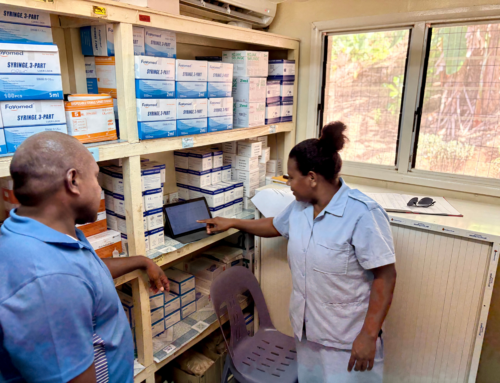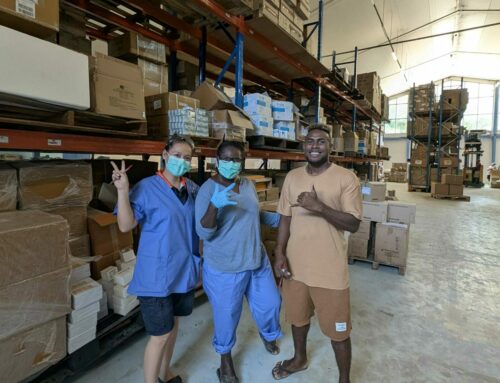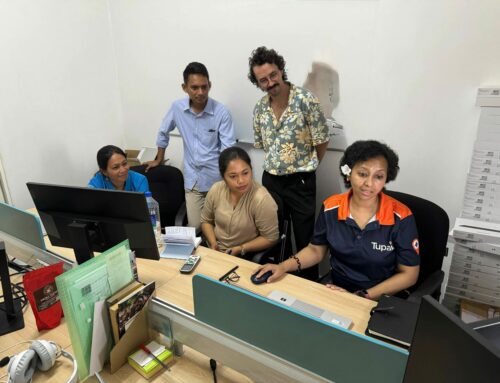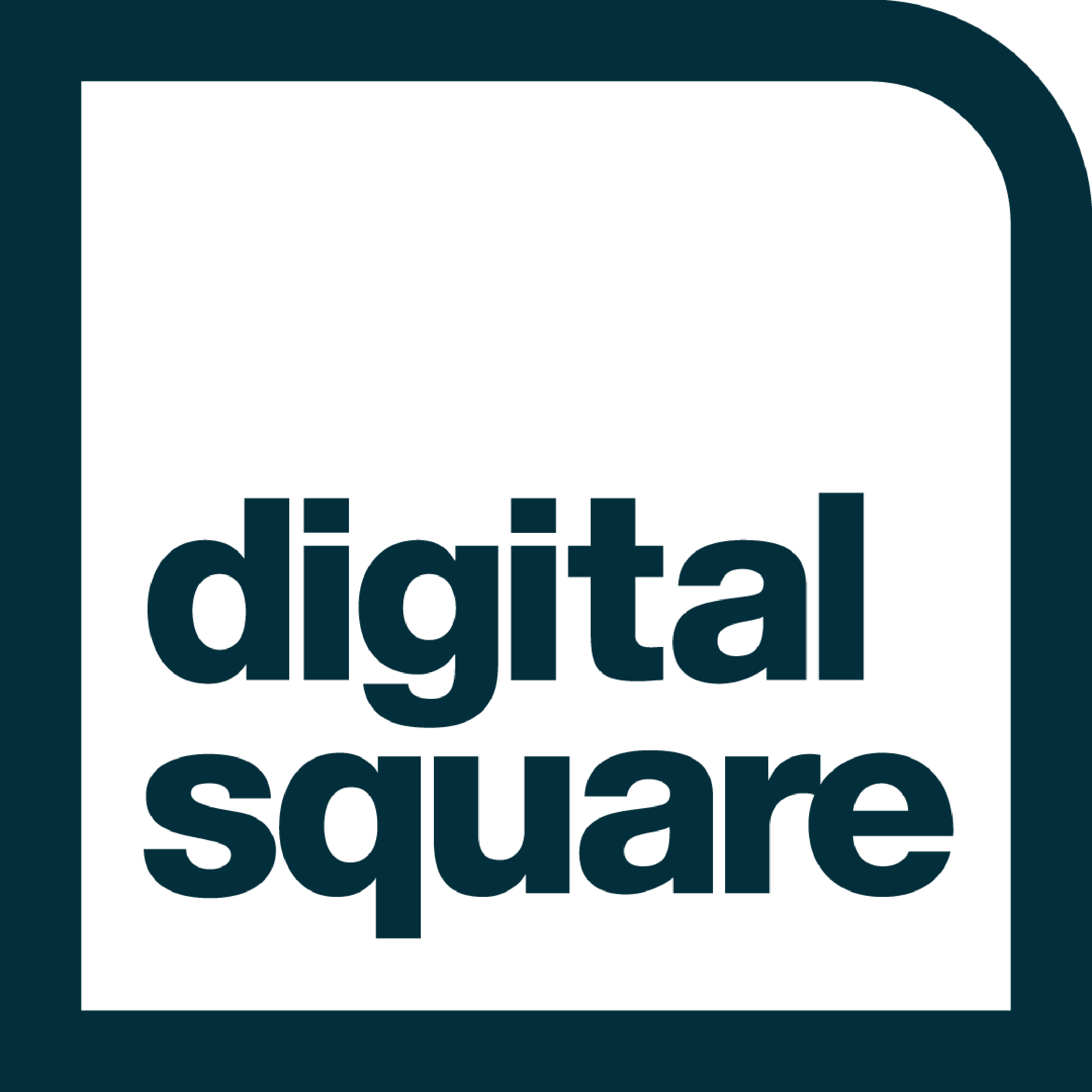Imagine you’ve been appointed as the Chief Pharmacist of a low-income country in the pacific region. It’s your first day on the job and you’re ready to make a real and tangible difference. You’re handed a large, well-worn folder (or maybe it’s a flash drive – stay with me here), each page containing data about a different clinic in a different region of the country. Most of it is months old, sometimes years old – you don’t even have a good sense of which clinics are which. How do you see the bigger picture? How do you compare and contrast what is working in one clinic and may be lagging behind in another?
This is the very real challenge faced by many health supply chain managers – usually pharmacists – across low-income countries in the region. Data is often incomplete or out of date, many facilities write their orders – by hand – once a month and have no avenue to provide feedback about what has arrived, what is working and what is not. Your job – and thousands of lives – hinge on the availability and condition of those medicines but you have no idea whether the clinic fridge is working, whether they’re using the medicines correctly or whether each clinic is even open.
Add to this the stress of trying to improve RUM across a diverse workforce, responding to disease outbreaks or preparing for the increasingly frequent disasters that beset their populations.
It is little wonder then that globally, medicines availability at the primary healthcare level remains extremely low. A 2014 study showed that primary healthcare centres in developing countries had on average just 40% of the essential medicines they need. First and foremost, this impacts patients and often means private clinics, NGO’s and other health providers shoulder the increased strain to maintain health services. It also impacts on donor and government funding and poor health outcomes impact disproportionately on other sectors, such as education and the labour force.
A new project called Tupaia is aiming to address these problems in the Asia Pacific region.
Tupaia is an important figure in Pacific history. He was a Polynesian who joined Captain Cook’s first mission through the Pacific as a navigator and translator in 1769. He was able to map the Pacific better than could be done with modern instruments of the time, by using the stars, the tides, birdlife, wind patterns and his own intuition. Tupaia died in Java in 1770 from what would now be considered a preventable illness (history records it as malaria or dysentery).
Too many Pacific Islanders still die unnecessarily today and that is a problem we are trying to fix.
Tupaia, which is supported by the Australian Government through DFAT’s innovationXchange, is a six-country project that aims to improve data availability and analysis for healthcare supply chain systems.
In simple terms, we’re helping governments NGO’s and donors see the bigger picture of health resources in each country. Where are clinics functioning well, with well trained staff and well supported communities and where are precious resources being wasted as, for example, medicines expire on the shelf unused or damaged equipment sits without repair.
At the heart of this project is www.tupaia.org. An interactive map that clearly presents relevant, up to date, customisable information to pharmacy staff, other health planners, donors and the public.
The Director of Pharmacy can easily identify which facilities have low availability of medicines and can target their resources more specifically to address these problems, the Minister for Health can look country-wide and see the average availability of medicines across all facilities to see whether particular policies are working. On a regional level, health planners can also see where too many antibiotics are being used, where vaccine stock-outs are widespread or where medicines usage appears to be out of the ordinary.
The Tupaia project is supported by several elements:
- The open-source release of an app called mSupply Mobile – a tablet-based electronic inventory system designed for use in clinics and health centres
- The free release of a health data collection app called Tupaia MediTrak. This allows any country to use the Tupaia model to collect and compare in country health data.
- The development of an integrated, multi-country database for better regional health planning
- The launch of an online data portal for that database at tupaia.org
So how does it work?
A program called mSupply, which is a desktop-based stock management software developed for healthcare systems in developing countries, has been used widely across the Pacific for many years. mSupply can handle procurement, warehousing, quantification and distribution of supplies – but once those supplies leave the warehouse, it was difficult to tell whether they were being used appropriately or which facilities had sufficient stocks.
In 2013, Solomon Islands piloted a mobile version of mSupply. The results of this pilot project were very encouraging and when a new version of the software was released in Timor-Leste in 2016, DFAT (through their new innovationXchange) agreed to fund the open-source release of the software, so its benefits could be replicated across the region.
With the prospect of good quality data coming in from several countries in the region, we showed that it could be more effective if it was brought together in a single place. After all, the software being used was the same in each country, it just required someone to combine the databases and build out a platform for people to access the information.
Just as Tupaia was able to bring together his vast knowledge of the tides and flows of the Pacific to guide Captain Cook, his namesake project will bring together a vast resource of health data to guide health policy and the distribution of resources.
In addition to collating the mSupply databases in each country (including both mSupply Desktop and mSupply Mobile), to track pharmaceutical supply chain management, the integrated database uses a health data collection app called Tupaia MediTrak to map every health facility in participating countries. The app collects data on hundreds of indicators, such as whether or not the facility has running water, what electricity source they rely on or whether they have sufficient staff housing. Via the website, this information can be quickly and easily disseminated in customisable dashboards to different user groups.
Already, in Timor-Leste, a version of Tupaia has been credited with helping to improve the availability of nutritional commodities and other medicines in facilities there. With the support of World Food Program, we started rolling out mSupply Mobile in facilities in Timor in 2016. By the end of 2017, we will have installed mSupply Mobile in 100 clinics and health centres, as well as mapping nearly 300 facilities with Tupaia MediTrak.
Since the middle of 2016, medicines availability has already increased by 20% in the country, whilst prices have reduced. We are able to track these changes on Tupaia and use that data to advocate for the continuation of pharmacy reforms in Timor-Leste.
Timor is also an example of being able to partner with a specific agency to address their specific needs. The World Food Program there uses the dashboards to track nutritional supplements at the facility level. When a facility is showing they have a stock out, WFP field officers immediately get in contact or travel to the facility to address the problem, rather than having to wait for periodic reports, or commit unnecessary time and expenses to visiting every site.
Timor is just one example of what we hope to achieve across many countries in the region. It’s simple really, access to more reliable, timely data helps all actors, from the Head of Pharmacy right down to the patients, make better decisions for themselves, their communities and improve the health outcomes across the region.
– You can explore information from Solomon Islands, Tonga and Kiribati already loaded onto our innovative map at www.tupaia.org – or stay in touch with the project and our mapping teams visiting clinics across far flung regions of Asia Pacific via Facebook (@tupaia.org) or Twitter (@tupaiahealth)





